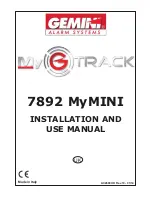
TM106601_(7/01) 2-
8
USE OR DISCLOSURE OF DATA CONTAINED ON THIS PAGE IS SUBJECT TO THE
RESTRICTION ON THE TITLE PAGE OF THIS DOCUMENT
.
C
O M M A N D
S
Y S T E M S
D
I V I S I O N
With an antenna connected to the waveguide installation, it may be desirable to test the entire
waveguide run including antenna for total VSWR. This must be done with the antenna pointing into
free space to avoid the possibility of reflective target interference. The total VSWR will be the result
of many factors in the waveguide and antenna. A long waveguide run may tend to increase the
VSWR. Therefore, a short run is more desirable. Ratios as high as 2:1 have been experienced
without noticeably disturbing the system operation, however, a lower VSWR is desirable. Insertion
loss is also increased with excessive waveguide length. The suggested maximum waveguide length,
including bends, should not exceed 10 feet for best performance.
2.7 POST-INSTALLATION CHECK
Tests involving radiation of RF energy by the
radar antenna must not be made in the
vicinity of refueling operations, or when
personnel are standing directly in front of the
radar antenna. RF energy is generated in all
modes except standby and test. Do not allow
personnel within 15 feet of area being scanned
by antenna when system is transmitting.
Tests involving the radiation of RF energy by the
radar antenna must not be made while the radar
antenna is directed toward close-by large metal
objects such as hangars, doors, or the inside of
the hangar. Use test mode or turn the indicator
function switch to off where applicable.
Note
+
Two persons with a means of communication
between them can perform the following
procedures efficiently. One person stationed in
the cockpit, and the second person mobile
between the transmitter location and the
antenna. The radome should not be installed
when performing these procedures.
WARNING
CAUTION















































